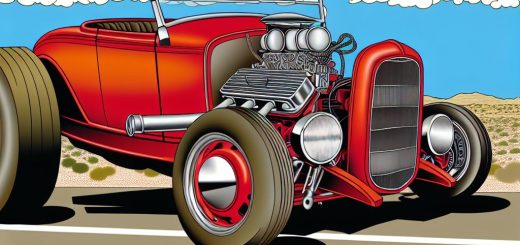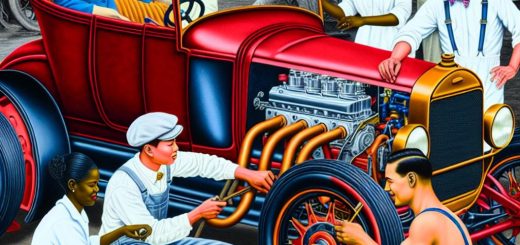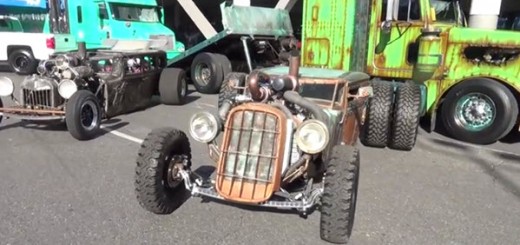Contents
The Historical Context of the 1932 Ford “Deuce Coupe”
The 1930s were a transformative period for the American automobile industry, with the Ford Motor Company leading numerous innovations. The 1932 Ford, colloquially known as the “Deuce Coupe,” was an important milestone in automobile history, representing a shift towards more powerful and affordable vehicles for the average consumer.
Introduction of the V8 Engine
One of the most significant aspects of the 1932 Ford was its engine. It was the first car from a mass-market manufacturer to offer an affordable V8 engine. Henry Ford’s introduction of the V8 engine set a new standard for power and performance in consumer vehicles. The flathead V8 engine offered robust performance and became extremely popular among car enthusiasts and the general public alike. This development marked a key shift in the automobile industry, making powerful engines accessible to a broader audience.
Ford’s flathead V8 engine, in particular, brought about a remarkable change in the way people viewed automobiles. Prior to the 1932 Ford, V8 engines were largely reserved for luxury models due to their complexity and cost. However, with the Ford offering this engine at a price accessible to the common man, the dynamics shifted. The flathead V8’s design enabled it to deliver a previously unattainable level of performance in a car intended for the average consumer.
The impact of this engine was not limited to engine power alone. It spurred innovation across the industry, pushing other manufacturers to explore new powertrains and engineering feats. Hence, Ford’s 1932 model wasn’t just another car; it was a catalyst for widespread change in automotive technology and consumer expectations.
Impact on Car Culture
The “Deuce Coupe” became an iconic symbol within the emerging hot rod culture in the United States. Its combination of appealing design, robust engine, and affordability made it a popular choice among young drivers and car customizers in post-war America. This vehicle was commonly modified to enhance its speed and performance. The hot rodding movement was a precursor to several car enthusiast cultures, emphasizing creativity and performance, and the 1932 Ford was at the center of this burgeoning trend.
During the mid-20th century, hot rodding evolved from a passion pursued by a few daring individuals to a full-blown cultural movement. The 1932 Ford was instrumental in this evolution, as its relatively straightforward design allowed car enthusiasts to modify it with ease. These modifications ranged from aesthetic changes, such as paint jobs and bodywork alterations, to more technical adjustments aimed at boosting engine power and speed.
As young, adventurous drivers embraced hot rodding, the 1932 Ford stood at the forefront of this subculture. Its versatility and the potential for customization made it an ideal canvas for those looking to express their individuality through their vehicles. The phenomenon of hot rodding ultimately laid the groundwork for today’s diverse car enthusiast communities, including tuner, muscle car, and other specialized automotive niches.
Design and Customization
The design of the 1932 Ford was another factor that contributed to its enduring legacy. It featured sleek lines and a style that blended the new with the familiar, making it attractive to a wide range of consumers. Many owners chose to customize these cars, enhancing their individuality and style. The simplicity of the car’s construction made it an ideal candidate for modification, which contributed to its popularity among hot rod enthusiasts who sought to improve performance and aesthetics.
The 1932 Ford’s design success rested on its ability to strike a balance between form and function. Its clean, horizontal lines conveyed a sense of motion even at a standstill, while the interior offered comfort — a comparatively novel concept at the time. Alteration enthusiasts would tweak the bodywork, engine, and wheels, exploring endless possibilities in the pursuit of speed and unique style.
This period marked the beginning of car customization as a mainstream practice. The simplicity of the vehicle’s mechanics allowed average individuals to work on their cars themselves rather than relying on specialists. This do-it-yourself attitude promoted a deep connection between owner and vehicle, fostering a unique relationship not only between driver and machine but also among those within the car culture community.
Legacy and Continued Influence
Even today, the 1932 Ford “Deuce Coupe” remains an influential figure in automotive culture. It is celebrated not only for its engineering but also for its cultural impact, as evidenced by its portrayal in films, music, and literature. The Deuce Coupe continues to be a cherished vehicle among collectors and car enthusiasts, reflecting its status as a timeless testament to American ingenuity and automotive passion.
In the modern era, the Deuce Coupe’s legacy is maintained through its ongoing presence in popular media and its role as a symbol of a bygone era’s innovative spirit. Many classic car enthusiasts view the ownership of a 1932 Ford as a nod to the early days of hot rodding and automotive customization. This respect is manifest in classic car shows and gatherings, where these vehicles are not only displayed but are also celebrated for their historical importance.
The 1932 Ford’s influence is also evident in the way it has inspired car manufacturers over the decades. Elements of its design and engineering can be seen mirrored in various models, especially those aiming to capture a blend of classic aesthetic appeal with modern performance. Overall, the Deuce Coupe’s contributions to car culture extend well beyond its initial production years, perpetuating a legacy of innovation, community, and passion that continues to resonate today.
The evolving interest in vintage automobiles ensures the preservation and celebration of models like the 1932 Ford. It remains a touchstone for discussions on automotive history, demonstrating Ford’s pivotal role in shaping consumer expectations and technological boundaries in the industry. As collectors and historians explore the legacy of vehicles like the Deuce Coupe, it becomes clear that its story is one of groundbreaking innovation and enduring cultural impact.






